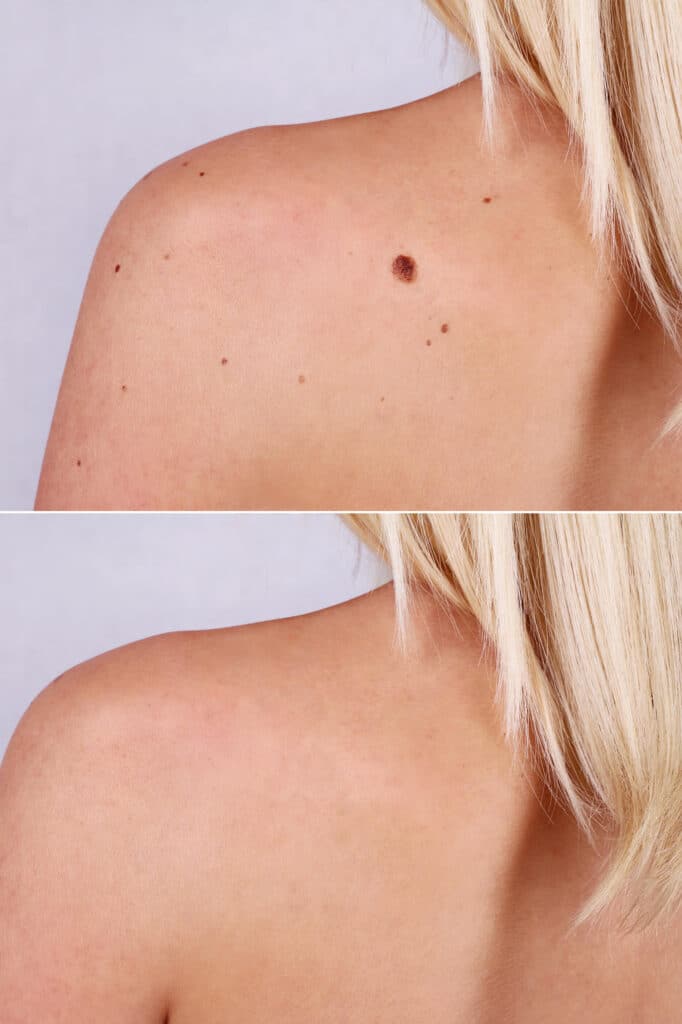What is this procedure?
While a mole removal surgery procedure is usually quick and uncomplicated, many people still feel apprehension about the prospect of even minor surgery. Nevertheless, sometimes mole removal procedures are necessary for your health – for example when your doctor suspects the mole might be cancerous.
Before the Procedure
The first step of the mole removal surgery process is for your doctor to measure, map, and in some instances, photograph the skin surrounding. Your doctor will sanitize the area surrounding the mole with an alcohol pad. Then inject it with a local anesthetic, typically lidocaine. Once the anesthetic takes effect, you should not feel anything at all in the numbed area.
Mole Removal or Biopsy?
For the patient, there is not much difference between the terms “mole removal” and “mole biopsy.” Essentially, a biopsy refers to taking a cell sample from a mole to a lab after it is removed to rule out skin cancer.
Typically, your doctor will decide a mole needs a biopsy if it has certain signs that make it suspicious:
- asymmetry
- irregular border
- different colors
- a diameter that exceeds a pencil eraser
- or a shape or size that is changing in some way
Nevertheless, every mole, even those supposedly removed for purely cosmetic reasons, is examined under a microscope. It is best to check every mole for signs of pathology so as not to miss a potentially deadly condition like melanoma.
During the Procedure
Your doctor will remove the mole, and sometimes some of the tissue surrounding it, with a sharp instrument like a scalpel. This isn’t supposed to be painful. If you do experience pain, let your doctor know – sometimes, you may need more lidocaine.
For smaller moles, the doctor will opt for a procedure known as a “surgical shave” – using a small blade to shave the off the mole and some of the tissue underneath.
The procedure typically takes a few minutes but may take up to an hour, depending on the mole’s size and how deep the doctor needs to cut to excise it. For deeper cuts, you will probably need a few stitches.
Another option that may be suitable is mole removal laser surgery, which does not require cutting or sutures.
After Mole Removal

Depending on the size of the mole, how deep your doctor had to cut to excise it, and how many stitches you had, mole removal surgery healing time may take anywhere from a few days to a few weeks. The healing area may feel sore, tender, or itchy, but you shouldn’t experience excessive pain – if you do, contact your doctor.
You may experience some bleeding when you first get home. If that happens, apply gentle pressure with a gauze or a clean cloth. If the bleeding doesn’t subside in 20 minutes, call your doctor.
Your doctor will recommend that you keep the area as clean and irritation-free as possible in all cases. If you have no stitches, they will probably instruct you to wash the area with soapy water once a day gently. Pat the area dry and apply an antibacterial cream or a thick neutral ointment, like petroleum jelly. Then change your adhesive bandage.
Patients who have stitches, and in particular, patients who have had deep mole removal surgery, are usually instructed to keep the area as dry as possible for a few days and refrain from strenuous exercise. It is best to consult your doctor before you get back to your normal routine.
If your mole was biopsied, the results should be ready within a week. Hopefully, they will be reassuring, and you can move forward with peace of mind. Otherwise, you and your doctor will discuss a treatment plan.
In some instances, you may notice that your mole begins to grow back after mole removal surgery. In this case, contact your doctor so that they can reassess your condition.
Scarring after Mole Removal
When you have a mole removed, it is almost certain that you will end up with a scar. The scar’s size and shape will typically depend on the size of the mole and on the procedure you needed to undergo to get it removed. Nevertheless, some scarring is practically unavoidable.
Scars will typically fade over time. You may want to discuss several options with your dermatologist to help the scar heal more quickly and effectively.
When it comes to mole removal plastic surgery, you want to know that you are in the hands of professionals. The dermatologists at Soma Plastics prioritize the health, safety, and well-being of our patients. Call us to make an appointment with a mole removal specialist and learn more about the mole removal process, mole removal surgery cost, and what you can expect.
